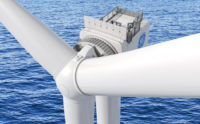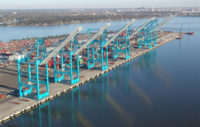The clean energy manufacturing arm of General Electic Co. plans to appeal a federal judge’s decision to ban it from U.S. market deployment of its Haliade-X offshore wind energy mega-turbine, the only 14-MW machine available, saying it infringes on a patent owned by Siemens Gamesa, a German-Spanish manufacturing rival.
In a ruling sought by the European firm following a federal jury verdict in June favoring it in key aspects of the patent dispute, Massachusetts federal district court Judge William Young said Siemens would suffer irreparable injury if it did not issue a permanent injunction against Haliade-X’s continued use by GE, saying legal remedies are inadequate to compensate Siemens for the injury.
The judge, however, allowed GE Renewables, which launched the mammoth turbine in 2018, an injunction carveout that allows the company to install 62 of the turbines at the Vineyard Wind-1 offshore wind project now being built off the coast of Massachusetts, as well as an undetermined number for use on the Ocean Wind 1 project off southern New Jersey.
The state sought the exemption in an August court filing, citing "detrimental effects" to its developing offshore wind energy supply chain and climate-change policies.
The injunction comes after the Boston jury found GE Renewables guilty of patent infringement and ordered it to pay $30,000 per megawatt in royalties for the 12-MW to 14-MW Haliade-X offshore wind turbines.
The royalty payment will raise the price of the 14-MW turbine by $420,000 and increase the cost of the 800-MW Vineyard Wind 1 project by $2.3 billion. The project is the first in the U.S. at utility scale.
GE also must provide a copy of the injunction to each of its existing and prospective customers with which it has discussed developing U.S. windfarms.
Legal Options
The manufacturer has orders for 11GW of offshore power using Haliade-X, of which 9MW face being blocked for delivery, according to industry consultant IntelStor. Vineyard Wind 1 and Ocean Wind 1 make up the remaining 2GW.
“Our customers are aware that we can and will explore other design options that enable us to bring the benefits of the Haliade-X to the U.S. We’re exploring all legal options to ensure that we can continue to support the growth of offshore wind in the U.S., including an appeal of today’s ruling,” a GE spokesman told ENR.
Judge Young said that nothing in the injunction prohibits GE from designing around the Siemens patent and if that happens, the U.S. manufacturer can seeks an injunction modification at any time.
“We have teams looking at design work-around options,” GE said, adding that the ruling also does not keep the firm from using the Haliade-X trademark. GE says it has strong arguments to support an appeal to the U.S. appellate court in Washington, D.C., and also may ask the judge to stay the injunction.
Siemens contends that it has lost significant portion of the offshore wind energy market share to GE and estimated that further losses from the U.S. firm's continued sales of Haliade-X using the patented technology could amount to the cost of up to 600 turbines during the life of the patent.
The patent, known as “413” provides a key element for the functionality of wind turbines creating a nexus between its use in the Haliade-X, and the harm Siemens faces in the market, the ruling said, adding that the patented technology's inventor said it was meant to anticipate and resolve problems in larger turbines specifically by reducing load on the rotor hub, which allows for bigger motors and more power. It also reduces the chances of offshore wind turbines failing.
Each Haliade-X turbne has a 220-meter-long rotor and 107-m blades.
GE argued that Siemens does not use the 413 patent. “It does not serve the public interest to lock up an invention and take it off the market for the sole purpose of harming a competitor,” the company said.
Judge Young disagreed. “Allowing GE to continue its infringing conduct would surely chill advancement of wind turbine and renewable energy technology and thus would defy the public interest in closely protecting valued patent rights,” he said, adding that in a lucrative emerging market the “aggregate value of America’s intellectual property and the integrity of its beneficial patent system would be incalculably diminished.”
However, Elizabeth Winston, a Catholic University of America law professor, said the ruling exemption for the two projects was “unusual,” with “far reaching impications,” she told Bloomberg Law because the judge balanced usual strong court defense of patent rights with allowing execution of contractual obligations that have major environmental and societal impact.






Post a comment to this article
Report Abusive Comment